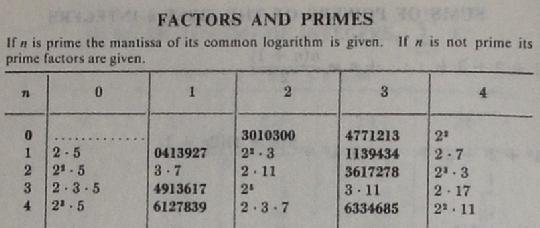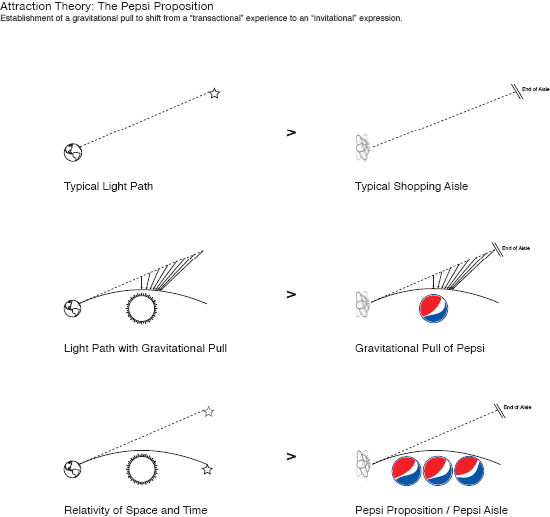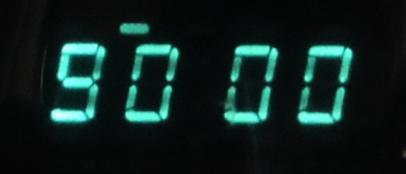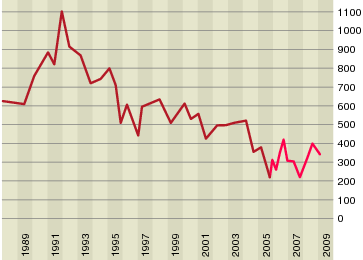|
 "If n is not prime its prime factors are given"--
"If n is not prime its prime factors are given"--1 is not prime, and indeed its prime factors (i.e., none) are given. 0 isn't prime either, but as there is no list (empty or otherwise) of primes whose product is 0, it is rendered with ............. , as if to say "not applicable". The table ends with 2009 (72 · 41). This is, of course, deeply symbolic: the world will end this year. When I was a kid, part of what I liked about chemistry was how the various elements have characteristic traits, like members of tribes. Metals and nonmetals have idiosyncratic and complementary habits, with a pecking order within each group. Carbon, positioned somewhere in the middle, plays a more subtle game that makes the richness of organic chemistry possible. The noble gases are the ascetics, indifferent and above the fray. That diversity can be seen as implicit; that is, the personalities of chemical elements follow from the ways of subatomic particles. An example from mathematics: just a few simple axioms (e.g., the definition of a group) can be the basis for a rich theory. It's valuable to appreciate how complexity can follow from simplicity. I'm a few weeks late here, but I bring all this up now to celebrate the 200th anniversary of Darwin's birth. It would never occur to me to use a chair in this manner. But then, I am not a dog.  In 1983, Steve Jobs recruited John Sculley (then President of PepsiCo)
to be CEO of Apple Computer. Legend has it that Jobs asked Sculley,
"Do you want to spend the rest of your life selling sugared water
or do you want a chance to change the world?"
In 1983, Steve Jobs recruited John Sculley (then President of PepsiCo)
to be CEO of Apple Computer. Legend has it that Jobs asked Sculley,
"Do you want to spend the rest of your life selling sugared water
or do you want a chance to change the world?"
PepsiCo, of course, continues to sell sugared water. To further that aim, Pepsi has a new logo--designed at no small expense by one Peter Arnell of the imaginatively-named Arnell Group. If reports on the web are to be believed, part of what Pepsi got for the not-small expense was a 27-page paper (PDF, 6.1 MB), so ludicrous and pretentious that it looks more like parody than the real thing. I try not to blog too much about idiocy (no sport in shooting fish in a barrel), but this example is noteworthy for how inane it is and how expensive it must have been. A sample: 
Why do I think the document is indeed Arnell's work? First, it's a very elaborate parody if it is one. Second, the Arnell Group web site is in the same vein: "Arnell is a multi-disciplinary brand and product invention company that executes across every consumer and trade touchpoint." Arnell Group did not respond to an inquiry about the document's authenticity. Pepsi dodged the question (smart thinking) but did write back to say Thank you for contacting us regarding our new logo. I've heard some of what's been said about the creative process involved, but I want to share with you that our new logo and graphics designs are the result of many months of planning and design. Pepsi’s face to the consumer has always evolved to stay relevant to the times, and I can assure you that our changes are consistent with the evolution of our logo and designs over the past 110 years. [...]Arnell's document had put it more grandly, calling their work "a strategy based on the evolution of 6000+ years of shared ideas in design philosophy creating an authentic Constitution of Design." I'm mystified. I cannot imagine how someone can generate a document like Arnell's. How do you bring yourself to talk that way. I'm also mystified by how dozens of companies (Pepsi is just one of Arnell's big clients) can stand to listen to such nonsense. In an article in Advertising Age magazine last month, Peter Arnell explained: "When I design things, I design in a pure vacuum." I'm still mystified; hypoxia alone doesn't explain how someone can be so full of shit.  Snow creep. Every so often, a thud. 
for Giles Today is a friend's sister's birthday, one of the generally-deemed-notable ones: a multiple of 10 years.People respond to round numbers. Multiples of 10 are just the most prominent because we use a decimal number system--but pace the Pythagoreans, 10 isn't a big deal. Multiples of 12 are in a sense rounder, and there are credible reasons why we would do well with base-12 numbering. Not that we'll ever change--base 10 is just another quirk we're probably stuck with forever, like the electoral college and the x86 architecture. Donald Knuth threw a big party for his 64th birthday. Ten trivia: the last digit of an ISBN is a check digit, even if it's an X (think of it as a Roman numeral). US Route highways are assigned one- or two-digit numbers for the main routes; north-south routes have odd numbers, starting with route 1 on the east coast and ending with route 101 on the west coast (with the 10 in 101 deemed a single digit). In a letter* written in 1760, Euler deemed Newton's particle theory of light untenable for several reasons--and instead tried to make a case for a wave theory, complete with the necessary medium (ether) throughout space. He even got snarky about it: ...you will certainly be astonished that [the particle model of light] could have been conceived by so great a man, and embraced by so many enlightened philosophers. But it is long since Cicero remarked that nothing so absurd can be imagined as to find no supporter among philosophers. For my own part, I am too little a philosopher to adopt the opinion in question.The hazard of being smug: the object of your derision may turn out to not have been so wrong after all. Euler's math has, of course, held up much better. * Letters of Euler on Different Subjects in Natural Philosophy, pp. 77-80 Does anyone know if there's a name for a type of humor where an absence of something is spoken of as if it were something? Sorry about how strange that description sounds; it's better illustrated by examples: I have major problems with lawyers telling me that, not only have no mistakes been made, but they have no responsibility for those mistakes (which have not been made, in any case). Every jumbled pile of person has a thinking part that wonders what the part that isn't thinking isn't thinking of. Dirac once said "God used beautiful mathematics in creating the world." Heisenberg recollects a friendly conversation among young participants at the 1927 Solvay Conference about Einstein and Planck's views on religion. Wolfgang Pauli, Heisenberg and Dirac took part in it. Dirac's contribution was a poignant and clear criticism of the political manipulation of religion, which was much appreciated for its lucidity by Bohr, when Heisenberg reported it to him later. Among other things, Dirac said: "I cannot understand why we idle discussing religion. If we are honest—and as scientists honesty is our precise duty—we cannot help but admit that any religion is a pack of false statements, deprived of any real foundation. The very idea of God is a product of human imagination... I do not recognize any religious myth, at least because they contradict one another..." Heisenberg's view was tolerant. Pauli had kept silent, after some initial remarks, but when finally he was asked for his opinion, jokingly he said: "Well, I'd say that also our friend Dirac has got a religion and the first commandment of this religion is 'God does not exist and Paul Dirac is his prophet.'" Everybody burst into laughter, including Dirac. |
